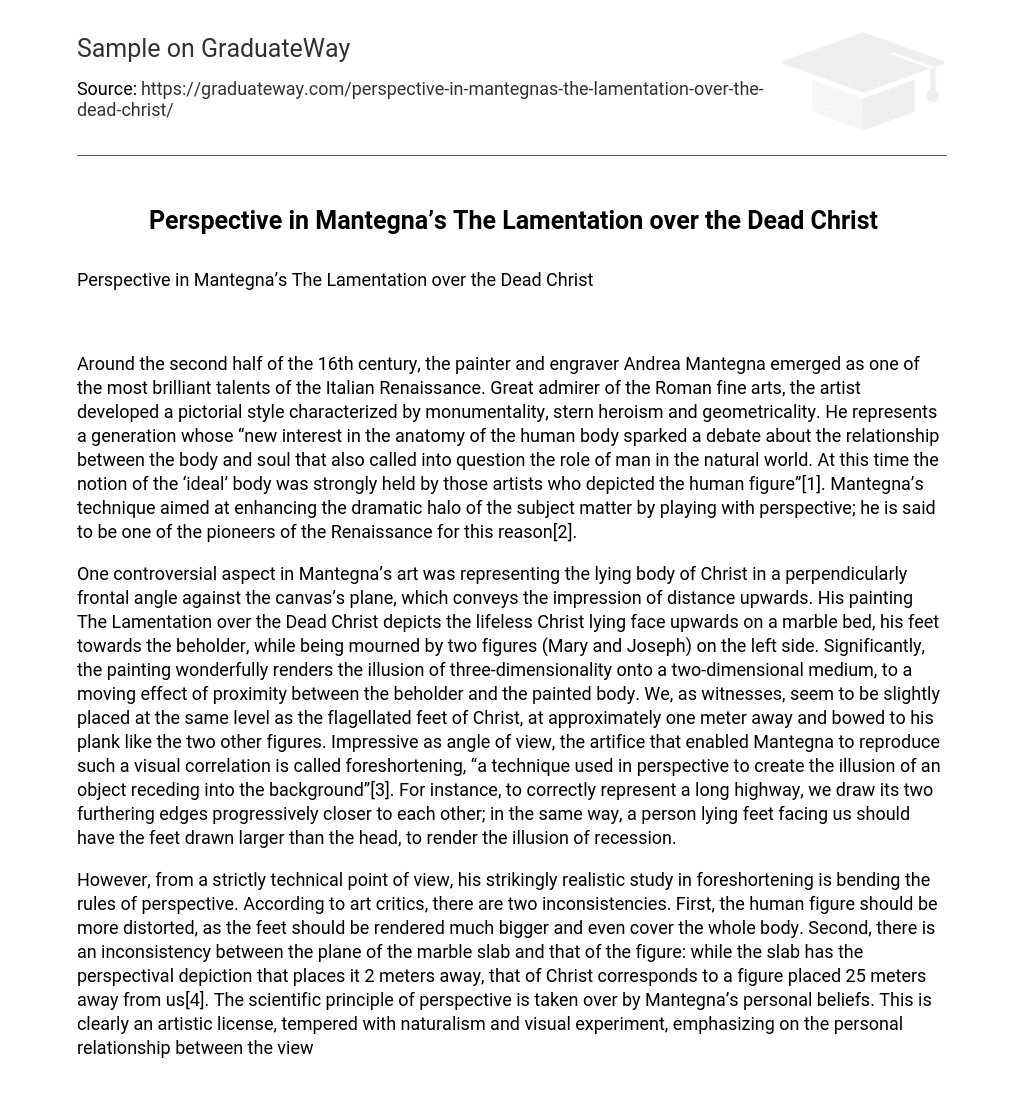Perspective in Mantegna’s The Lamentation over the Dead Christ
Around the second half of the 16th century, the painter and engraver Andrea Mantegna emerged as one of the most brilliant talents of the Italian Renaissance. Great admirer of the Roman fine arts, the artist developed a pictorial style characterized by monumentality, stern heroism and geometricality. He represents a generation whose “new interest in the anatomy of the human body sparked a debate about the relationship between the body and soul that also called into question the role of man in the natural world. At this time the notion of the ‘ideal’ body was strongly held by those artists who depicted the human figure”[1]. Mantegna’s technique aimed at enhancing the dramatic halo of the subject matter by playing with perspective; he is said to be one of the pioneers of the Renaissance for this reason[2].
One controversial aspect in Mantegna’s art was representing the lying body of Christ in a perpendicularly frontal angle against the canvas’s plane, which conveys the impression of distance upwards. His painting The Lamentation over the Dead Christ depicts the lifeless Christ lying face upwards on a marble bed, his feet towards the beholder, while being mourned by two figures (Mary and Joseph) on the left side. Significantly, the painting wonderfully renders the illusion of three-dimensionality onto a two-dimensional medium, to a moving effect of proximity between the beholder and the painted body. We, as witnesses, seem to be slightly placed at the same level as the flagellated feet of Christ, at approximately one meter away and bowed to his plank like the two other figures. Impressive as angle of view, the artifice that enabled Mantegna to reproduce such a visual correlation is called foreshortening, “a technique used in perspective to create the illusion of an object receding into the background”[3]. For instance, to correctly represent a long highway, we draw its two furthering edges progressively closer to each other; in the same way, a person lying feet facing us should have the feet drawn larger than the head, to render the illusion of recession.
However, from a strictly technical point of view, his strikingly realistic study in foreshortening is bending the rules of perspective. According to art critics, there are two inconsistencies. First, the human figure should be more distorted, as the feet should be rendered much bigger and even cover the whole body. Second, there is an inconsistency between the plane of the marble slab and that of the figure: while the slab has the perspectival depiction that places it 2 meters away, that of Christ corresponds to a figure placed 25 meters away from us[4]. The scientific principle of perspective is taken over by Mantegna’s personal beliefs. This is clearly an artistic license, tempered with naturalism and visual experiment, emphasizing on the personal relationship between the viewer and the Christ. Actually, science here serves the purpose of devotion.
Essentially, Mantegna presents both an anatomic study of a foreshortened corps and an incredibly close breach in an existential plane. Having the Christ represented like that is consistent with the Middle Ages’ somber vision that the human kind is implacably guilty. Putting Christ’s cadaver under the “magnifying glass” of such a perspective inspires a cosmic tragedy and calls to perpetual remorse and devotion. It is a meditation on the edge of death.
Even though it may not be mathematically flawless or photographically correct, the technique of Mantegna served as a meaningful springboard for a spiritual perspective. Placing the beholder 2 meters away from the feet of the dead savior is a witty mise-en-scene of an existential moment of dramatic magnitude. To my view, the technical miss outs are compensated by the psychological or religious intensity, as the significance of death and life are requestioned at a cutting-edge level. The craftsmanship and aesthetic innovation in transforming the conventional system of two-dimensional representation have made Andrea Mantegna the pinnacle of almost a century of experiment in perspective.
Resources:
“Art Glossary: Foreshortening”. About.com. Painting. The New York Times Company, Inc. 12 Mar 2008 <http://painting.about.com/od/artglossaryp/g/defperspective.htm>
“Mantegna, Andrea.” Columbia Electronic Encyclopedia. Columbia University Press. 15 Mar. 2008. <Reference.com http://www.reference.com/browse/columbia/Mantegna>.
Smith, Robert. “Natural Versus Scientific Vision: The Foreshortened Figure in the
Renaissance.” Gazette Des Beaux-Arts LXXXIV (October 1974): 239-248.
Starling, Dan. “Knowledge and Identitiy: Andrea Mantegna’s Lamentation over the Dead Christ.” (online article) 13 Mar 2008. <http://www.danstarling.com/page39.html>.
“Thematic development of Italian Renaissance painting.” Wikipedia, The Free Encyclopedia. 4 Mar 2008, 04:25 UTC. Wikimedia Foundation, Inc. 12 Mar 2008 <http://en.wikipedia.org/w/index.php?title=Thematic_development_of_Italian_Renaissance_painting&oldid=195729055>.
[1] Starling, Dan. “Knowledge and Identitiy: Andrea Mantegna’s Lamentation over the Dead Christ.” (online article) 13 Mar 2008. <http://www.danstarling.com/page39.html>.
[2] “Mantegna, Andrea.” Columbia Electronic Encyclopedia. Columbia University Press. 15 Mar. 2008. <Reference.com http://www.reference.com/browse/columbia/Mantegna>.
[3] “Art Glossary: Foreshortening”. About.com. Painting. The New York Times Company, Inc. 12 Mar 2008 <http://painting.about.com/od/artglossaryp/g/defperspective.htm>
[4] Smith, Robert. “Natural Versus Scientific Vision: The Foreshortened Figure in the
Renaissance.” Gazette Des Beaux-Arts LXXXIV (October 1974): 239-248.





